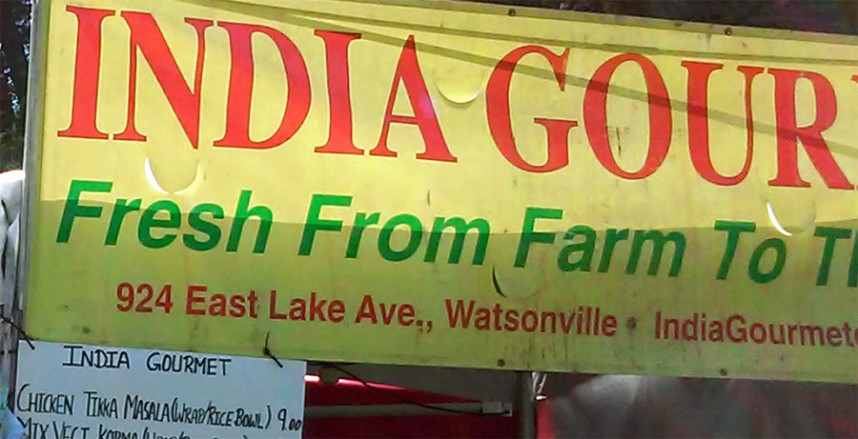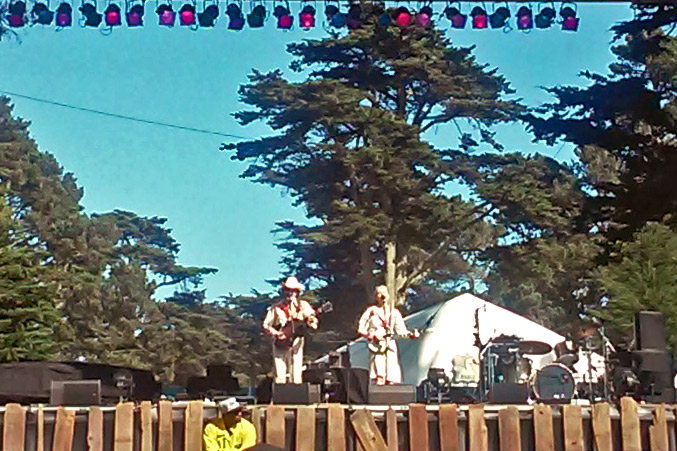Started my Saturday with an 8 a.m. moving job, not a brilliant idea considering I have a (very) bad back, had done more walking up & down steep slopes getting in & out of the festival (Hellman Hollow, formerly known as Speedway Meadow, named after the founder of Hardly Strictly Bluegrass, Billionaire Venture Capitalist Warren Hellman) than I had done in a couple of years, combined with the standing or sitting on the ground all day on the previous day– especially in light of the fact that I was planning on doing the same that and the following day, but…
After the moving job (which provided badly needed cash, and was extremely easy at that) I went home, showered & changed clothes, packed the bare minimum of supplies for a day at a large music festival, and headed off to the Festival earlier than I probably would have, had I allowed myself to sleep in. But, tired but content (with a few extra shekels from the move), I arrived there shortly before the first act, Chatham County Line.
Talk about “Unplugged”…
Yes folks, that is four musician/vocalists singing and playing into one microphone! This is Chatham County Line, all the Way from North Carolina. How they were able to manage such a clear sound & dynamic range, without benefit of having any of their instruments plugged in, is beyond me, but not beyond this bunch:
I just wish I knew what sort of Omni-Directional Microphone they were using for this. What they were playing wasn’t really Bluegrass per se, but kind of a pop sound playing on traditional bluegrass instruments: guitar, stand-up bass, banjo, mandolin, and violin on one song. I forgot their roundabout introduction for this song, something ironic about “old & traditional” before playing a 60s era Rolling Stones tune, “This could be the Last Time”, They did a great job on it, even covering that edgy, distorted lead guitar figure in the original using mandolin & banjo– and their harmonies on the chorus were much better than on the Stones’ version.
Next up was Laurie Lewis and the Right Hands, which included some local musicians– including a kid (named Max Schwartz, I think) playing stand-up bass from the Berkeley High School Jazz Band– and as she introduced him she cracked he was planning on going on the road with some Bluegrass Group after graduation. She had a more traditional sound, including a cover of Emmylou Harris’ “Orphan Girl”. Of the Bluegrass groups I heard at the festival, her group kept the tightest rhythm, although they never really played at anything resembling a breakneck pace.
Here’s a (very badly recorded, using a hand-held $29 phone camera in a pretty stiff breeze) video of Laurie Lewis and longtime musical partner Tom Rozum (on lead vocals here), and they were joined by a trio making the Bluegrass Circuit this year called the T Sisters, and I was able to record the second verse (which used up most of my phone’s memory, but…
This is the point at every HSB Festival where I find it inconceivable that the facilities are not equipped with Space-Time Portals to shuttle you between two acts that you want to see, but who happen to be playing at the same time on another stage. Hot Tuna was coming up next on the Banjo Stage, but I also wanted to see Dave and Phil Alvin who were playing at the very same time a quarter mile away on the Swan Stage. Jorma Kaukonen (Hot Tuna) and Dave Alvin (Blaster, X, Knitters) both have very roots-based styles of guitar, which I very much like listening to: Jorma drawing on the Ragtime finger-picking influence of the Reverend Gary Davis, and Dave Alvin drawing on an Americana/Rockabilly style, filtered through his experience on the LA Punk scene playing with the Blasters and X. I kind of wanted to see Dave & Phil, figuring it would be a lot more high-energy, but plowing through a crowd of a quarter million Festival Goers for a quarter mile just to try to find myself a seat for just one set, before immediately heading back to the Banjo Stage to see Gillian Welch did not strike me as my idea of fun. Between sets I asked my “neighbors” if they would be kind enough to save my seat while I wandered over to the food stands to get some lunch. And being very nice people they said they would.The crowd at Hardly Strictly Bluegrass, which has been estimated to number about a quarter of a million concert-goers per day, is a really relaxed, friendly and courteous crowd for something this big…

So today, after having had the Cajun-style Étouffée the day before, I went to an Indian food stand (right next to the Louisiana food stand as it turns out) and ordered some Tikka Masala Chicken over rice, which was good, and leisurely ate my food off to the side of the concert crown, and then on the way back to my seat passed some people that were eating something that looked pretty darn good, and asked what it was. It was Paella, so I scrapped my plans to have Chicken Shwarma for my Sunday meal, and decided I was going to have the Paella the following day.

Got back to my seat just as Hot Tuna was warming up on stage, and listened to a pretty good, but not particularly inspired (inspiring?) set of well-played… Electric Ragtime, for lack of a better description. Oddly, if there was anyone playing lead “guitar” in this group, it was Jack Cassidy on bass, who drove the rhythm as he added melodic/harmonic complexity to the band’s set.
Next up on the Banjo Stage was Gillian Welch

(who had, by the way, recently received a Lifetime Achievement Award for Songwriting from the American Music Association. she joked “does that mean we’re supposed to be dead?”) For the set she and Dave Rawlings came out in matching Buckskin Leather outfits, and performed a set of somewhat traditional Country Folk, performing songs that were a bit more thoughtful and intelligent than the usual offerings of Country Western. Dave Rawlings guitar solos were especially notable because he played them on an acoustic guitar, and was able to play in registers that are usually confined to the electric guitar.
On the schedule for the next set was Ry Cooder playing with Ricky Skaggs. When they came out, I wasn’t able to recognize Ry Cooder on stage. The group, apparently was Ricky Skaggs, and they started the set with a sort of “Blood of the Lamb” Country-Gospels song, which I wasn’t particularly crazy about, and the guy who took the solo didn’t look anything like Cooder when I saw him once before, and the guitar solo wasn’t very inspired, and didn’t sound anything like I would expect from him. In the weeks before the festival there were rumors that Ry would play, or he wouldn’t play. In any case, if he was there (which I was told he was), I really couldn’t tell.
It was a little after 4 p.m.; I was planning on heading over to the Arrow Stage to see the Flatlanders (Joe Ely, Jimmie Dale Gilmore and Butch Hancock) at 5:30, but right around that time, a decidedly younger crowd was arriving. These were a decidedly an “Entitlement Kiddie” crowd, pushing their way to the front as if the people who were already there were somehow just furniture to be pushed out of their way as they made their way to the front; and even though they were arriving not too long before the end of the program, they all seemed to be carting in enough beer– in 12-packs, cases or full-size coolers on wheels– to last them an entire weekend of dissipation. They seemed like hardened veterans of the Summer Coachella/Outer Lands $200 a ticket Music Festival Circuit and, by God, if their parents shelled out this much money for tickets, they damn well better get the prime seats! Anyway, (again) even though they were arriving near the end of the day’s program, they seemed to be swarming in by the hundreds, over the hills separating Speedway Meadows (or Hellman Hollow, as it has been renamed), taking trails that weren’t even trails– it seemed like something you’d see on the Nature Channel late at night, and I really wasn’t feelin’ it to hang out for an hour and a half to see the Flatlanders, so I decided I’d come back tomorrow to see my favorite band, Los Lobos, the following evening.
